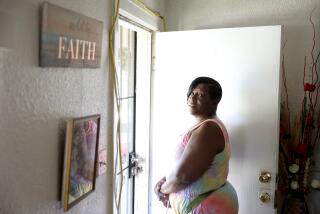County to Begin Recruitment Campaign for More Foster Homes
- Share via
When an abandoned newborn baby was found two years ago in a Fountain Valley trash bin, the nurses at Fountain Valley Community Hospital were so taken with him that they named the child Baby Jeffrey and lined up in the ward to see him.
In the following days, county adoption and foster care offices logged more than 300 calls inquiring about taking in the redheaded infant, whose parents never came forward to claim him.
However, a second Baby John Doe found earlier this year in Orange did not receive such an outpouring of community support. Although he was placed last month with a foster family, no one called to offer foster care for the child.
Officials said the contrasting responses reflect a crisis in available county foster care. As a result, the county Social Services Agency requested that the Board of Supervisors approve funding for a publicity campaign advocating foster parenthood.
This week, the board approved the campaign, which will use a marketing survey of county foster parents to determine how to best recruit potential foster homes.
County officials said the declining number of available foster parents compared to an increasing number of children needing foster care has made foster placement more difficult in recent years. Because of this, the county children’s emergency shelter--Orangewood--has been almost always completely filled since it opened in November.
The new county advertising campaign should succeed both in easing overcrowding at Orangewood and better preparing children for placement in adoptive homes or reunifying them with their parents, said county adoptive services official Bob Christopher.
Publicity on Baby Jeffrey’s plight was successful in soliciting foster-parent candidates in 1984, but even the news of three abandoned babies this year in Orange County did not reverse the decline in available foster homes, said Barbara Labitzke, foster home development coordinator for the county.
The number of licensed county foster homes has decreased from 687 in January, 1984, to 563 in December, 1985, while the number of children entering court custody increased from 2,098 in 1984 to 2,412 in 1985, according to Social Services Agency statistics.
While some of those children included in the court custody figures are still living with parents or relatives under supervision, the majority need foster home placement, said adoptive services official Mary Harris.
“We used to have a choice of foster homes,” but now the agency has a waiting list of children rather than of foster parents, Harris said.
Labitzke attributed the decline in the foster home pool to the fact that many foster parents end up adopting their charges and also to the increase in working mothers and single-parent families.
Single-parent homes and families with working wives can qualify to provide foster care if the families can ensure that foster children will be supervised while the parents are at work. However, a prohibitive factor often is that the cost of day care equals monthly foster care payments.
Baby Jeffrey was courted by several people nationwide who were willing to give him foster care at the risk of losing him before adoption if his parents came to claim the child.
He was placed in a foster home immediately after being released from the hospital when he was 1 month old. His foster parents were allowed to adopt him after six months.
Adoption privacy laws prevented agency officials from revealing details about Baby Jeffrey’s new identity or his family’s whereabouts. However, Harris said he was healthy when the agency stopped its follow-up visits one year ago.
Foster parents of the unidentified baby boy found in March have applied to adopt him after the mandatory six-month waiting period. Like Baby Jeffrey’s adoptive parents, they agreed to provide foster care only because it gave them a better chance of adopting the child.
However, Labitzke said that most people who place themselves in this situation run a great risk of disappointment if the child must be reunited with the natural parents.
“We’ve always said foster care is not a back door to adoption,” she added. “Our primary goal is reunification with the natural parents. . . . But in reality, more foster parents are becoming qualified to adopt.”
Labitzke is seeking to recruit people whose primary goal is not adoption. Foster parenting itself “is an opportunity and a challenge, and the possibility of sharing an important time in a child’s life. . . . Foster parents who are with a child 24 hours a day have more chance to (help him) than any program.”
Both Labitzke and Harris acknowledge that foster parenting is often very painful if the child must be taken away.
“We talk with (prospective foster parents) very seriously about what they leave themselves open to,” Harris said.
Also, many children who need foster placement have been severely abused and need a “lot of love and patience” before they can become adjusted to normal family life, Harris said.
Still, Labitzke said she anticipates an increase in the foster parent ranks because of the county publicity campaign, adding: “I believe children are hard to turn your back on.”
More to Read
Sign up for Essential California
The most important California stories and recommendations in your inbox every morning.
You may occasionally receive promotional content from the Los Angeles Times.













